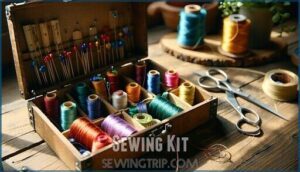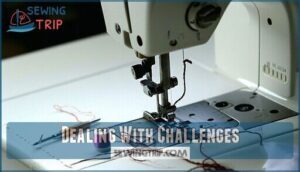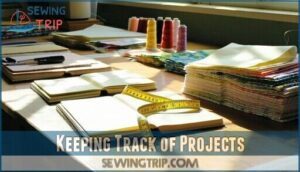This site is supported by our readers. We may earn a commission, at no cost to you, if you purchase through links.

Start by gathering essential tools like a sewing machine, fabric, and notions. Master basic stitches and techniques, such as running stitch and hemming.
Practice regularly to build confidence and skills. As you progress, you’ll discover new techniques and projects to try, from sewing on the go to attending sewing retreats, and you’ll be keen to see what other sewing adventures await you.
Table Of Contents
Key Takeaways
- You’ll start sewing by gathering essential tools like a sewing machine, fabric, and notions, and mastering basic stitches and techniques, such as running stitch and hemming.
- As you prepare for sewing on-the-go, you’ll plan ahead with project planning and fabric selection, and pack a travel sewing kit with essentials like needles and thread.
- You’ll encounter various challenges while sewing, but being aware of how to overcome them is vital – consider task lighting, packing cubes, and a trustworthy iron to make your sewing experience more enjoyable and efficient.
- To keep track of your projects and stay organized, you’ll use tools like a diary or notes, writing down details to remember your travels and reflect on successes and lessons learned, and tracking your progress to become a proficient sewist.
Preparing for a Sewing Trip
When preparing for a sewing trip, plan ahead with project planning and fabric selection.
Plan ahead with project planning and fabric selection for a smooth sewing trip experience
Pack a travel sewing kit with essentials like needles and thread.
Maintain your tools and optimize space to guarantee a smooth trip.
Consider your sewing tools and kit to make the most of your travel sewing experience with complete concepts.
Packing for Sewing on The Go
You’re getting ready to sew on the go, and to pack the right tools and materials is vital.
You’ll want to gather a notebook, sewing kit, fabric, and tools like scissors and needles to guarantee you have everything you need to complete your project, which includes having the necessary items like sewing kit.
Notebook
As you pack for sewing on the go, consider bringing a notebook to track your project planning, design sketches, and pattern notes.
Include stitch samples and fabric swatches to reference later.
This notebook will be your sewing bible, helping you stay organized and inspired throughout your sewing projects, especially for beginner sewing tutorials.
Sewing Kit
You’ll want a sewing kit with kit essentials like a needle variety, thread selection, and scissor types.
Measuring tools are also a must. Your sewing kit should include these sewing tools and sewing essentials to guarantee you’re prepared for any project, with the right sewing supplies and accessories always at hand.
Having a dedicated kit guarantees you have necessary sewing products readily available.
Fabric
When sewing on-the-go, consider your fabric selection guide, choosing fabric types like cotton, and pre-washing to guarantee the right fabric weight and grain.
Making cutting fabric a breeze, and helping you prepare for a successful sewing project with the right fabric preparation.
Tools & Notions
Organization is key when you’re packing your sewing essentials.
Don’t forget your sewing tools and sewing notions.
You’ll need fabric scissors, measuring tools, marking pens, and an assortment of thread types.
Needle sizes matter.
A sewing machine might be too bulky.
Schmetz needles are versatile options.
Here’s a handy checklist:
- Needles
- Thread
- Scissors
- Fabric
Remember to choose your fabric carefully and pack smart to sew happy.
Sewing in Different Settings
You’re about to explore sewing in different settings, which can be a fun and creative experience.
As you sew in various locations, such as at home, outdoors, or in hotels, you’ll learn to adapt your techniques and tools to suit each environment, making it a creative experience.
Home & Outdoors
At home or outdoors, you’ll find numerous sewing projects.
Create patio cushions, garden décor, or picnic blankets using outdoor fabrics and a sewing machine.
Consider the best outdoor materials for durable projects.
As a beginner, start with simple sewing tools and projects like camping gear repairs to build your skills and confidence in sewing.
Hotels & Vacation
When traveling, consider Hotel Sewing Kits and Vacation Project Ideas.
Setting up a sewing space in your hotel room can be challenging, so pack a portable Travel Sewing Machine and source fabric abroad for unique sewing projects.
Keeping your sewing tips and tutorials in mind for beginners is essential to making the most of your travel sewing experience.
Dealing With Challenges
You’ll encounter various challenges while sewing, and being aware of how to overcome them is vital.
By understanding the common obstacles, such as poor lighting or inadequate tools, you can develop strategies to deal with them effectively and continue sewing with ease.
Lighting
When setting up your sewing space, consider task lighting with adjustable color temperature.
Proper light placement and utilizing natural light can enhance your sewing environment.
Invest in a good sewing lamp to create an ideal sewing room setup and workspace, making your sewing experience more enjoyable and efficient always.
Packing Cubes
When sewing on-the-go, you’ll appreciate packing cubes for their organization benefits. Cube materials like old bedsheets work well, and zipper types with compression features help.
Having a size variety guarantees your sewing projects fit securely. For sewing beginners, packing cubes keep materials organized, making it easier to focus on sewing techniques and easy projects.
With cubes, you can efficiently store and transport your sewing kit, fabric, and tools, streamlining your sewing experience. You can find various sewing cube products online, which can greatly aid in on-the-go sewing.
Iron
When dealing with challenges, you’ll find that having the right iron makes a big difference. Consider these key points:
- Adjustable iron temperature
- Fabric pressing techniques
- Seam pressing methods
- Iron maintenance tips
- Travel iron options
Having a trustworthy iron is one of the sewing tools essentials. You can use it with your sewing machine and ironing board to achieve professional results.
Ironing and pressing aren’t the same, so it’s important to understand the difference to get the best out of your iron.
Table
You’ll find a small, fold-up table handy for sewing in hotel rooms.
It provides space to spread out projects.
Consider a tablecloth or table runner to protect your work surface, making sewing on-the-go easier with your sewing machine and fabric, and exploring various sewing projects ideas.
Keeping Track of Projects
You’ll find it helpful to keep track of your sewing projects using tools like a diary or notes.
By doing so, you can easily monitor your progress, remember what you’ve learned, and stay organized as you work on multiple projects at once, which helps you stay organized.
Diary
You’ll stay organized by keeping a diary of your sewing projects.
Keep a sewing diary to track progress and stay organized
Writing down details helps you remember your travels and reflect on successes and lessons learned.
This record motivates you to continue creating, facilitating sewing reflections and personal growth.
It’s a tool for project tracking, skill development, and exploring creative expression, perfect for sewing basics and beginner sewing projects.
Notes
As you begin your sewing journey, taking detailed notes is vital.
You’ll capture helpful tips and tricks for future reference.
Note-taking methods, such as inspiration logging and project journaling, help track progress.
Sketching designs and logging pattern alterations will also aid in your sewing learning.
For sewing beginners, a project journal is essential.
It provides a space for sewing advice and sewing basics.
By incorporating these habits, you’ll become a proficient sewist, equipped with valuable sewing guide and expertise to tackle various projects with confidence and precision, making sewing for beginners a breeze.
Consider exploring die cutting applications to add unique embellishments to your sewing projects.
Attending Sewing Retreats
You’re heading to a sewing retreat, a great chance to enhance your sewing skills.
Pack pre-cut fabric, a sewing machine, and specialty tools.
Attend sewing workshops, classes, and events to socialize with the sewing community, focusing on project development and skill building, and enjoy the retreat benefits.
Downloadable PDFs
You’ve just attended a sewing retreat, now it’s time to take your skills to the next level with downloadable PDFs.
These resources include Pattern PDFs, Printable Guides, and Sewing Templates to help you create professional-looking projects.
With PDF Tutorials and Digital Instructions, you’ll learn how to printing patterns, assembling patterns, and tracing patterns with ease.
Utilize these tools to master sewing patterns and PDF patterns, and don’t forget to explore the sphere of digital sewing guides.
Many sewers also enjoy working with free hand embroidery to add unique details.
By doing so, you’ll become more confident in your sewing abilities and be able to tackle complex projects with precision and accuracy, making the most out of your sewing experience.
Outdoor Sewing & Binding
You’re moving on from downloadable resources to outdoor sewing and binding. For outdoor projects, consider weatherproofing fabrics and using binding techniques to prevent fraying.
Portable sewing machines are handy for repairing gear on-the-go. As a beginner, start with simple sewing tutorials and practice working with outdoor fabrics.
Binding techniques can be used to finish hems, collars, or cuffs on fleece sewing projects. When sewing heavy materials, consider using a walking foot machine for better fabric feed.
Use stretch binding for a professional finish and explore various binding materials, such as Sunbrella acrylic bias binding tape, for your outdoor sewing needs, making your sewing projects more durable and long-lasting.
Encouragement & Ideas
You’re making great progress with your sewing projects.
For sewing inspiration, consider:
- Exploring fabric choices to spark creativity
- Trying pattern adaptations to build skills
- Seeking project inspiration online or in books
- Joining sewing communities for encouragement and ideas.
This will help you with creative exploration and skill building, making sewing for beginners more enjoyable.
Remember, sewing projects ideas are endless, and with practice, you’ll become more confident in your abilities, leading to a world of sewing encouragement and exciting new projects.
You’ll find that with time, your skills will improve, and you’ll be able to tackle more complex projects, sparking new ideas and confidence in your sewing abilities.
Thanks & Happy Quilting!
You’ve reached the end of this sewing journey.
Thanks for joining in – now, go ahead and happy quilting!
As a member of the Quilting Community, you’ll find Inspiration Sources and Project Sharing to fuel your Skill Development.
Explore sewing projects ideas and quilting for beginners to expand your skills.
With fabric and sewing for beginners as your foundation, you’ll be creating stunning pieces in no time.
Look forward to Future Projects and the joy of sewing.
Frequently Asked Questions (FAQs)
How do I start a sewing career?
You’ll set out on a creative journey, much like a painter with threads, by learning basics, practicing stitches, and starting small projects to build skills and confidence in sewing.
Can I teach myself sewing?
You can teach yourself sewing with patience, online tutorials, and practice, starting with basic stitches and projects to build skills and confidence.
How do I start sewing as a hobby?
You’ll start sewing as a hobby by choosing beginner-friendly fabrics, investing in essential tools, and practicing basic stitches like the running stitch and backstitch to build confidence and skills.
What type of fabric should I use for sewing?
You’ll want to use cotton, linen, or flannel fabrics, which are great for beginners due to their ease of handling and piercing, making your sewing experience more enjoyable and stress-free.
What is the best way to store fabric while traveling?
A stitch in time saves nine." You’ll store fabric in airtight bags or containers, keeping it clean, dry, and wrinkle-free while traveling, making it easy to sew later.
What are the benefits of attending a sewing retreat?
You’ll gain hands-on experience, feedback, and connections with fellow sewers, enhancing your skills and confidence in a supportive environment at a sewing retreat.
Are there any tips for using a sewing machine outdoors?
You’ll need a portable sewing machine, outdoor cover, and stabilizing tools to sew efficiently and safely outdoors, protecting your machine from elements.
What items should I include in a sewing kit?
Building a sewing kit is like packing a toolbox, include essentials like needles, threads, scissors, and a measuring tape to get started with your sewing projects efficiently.
What fabrics work best for beginners?
You’ll find cotton, linen, and flannel are great fabrics for beginners, easy to handle and pierce, making them perfect for practice and small projects.
How to choose the right sewing needles?
You’ll select sewing needles based on fabric type, thread size, and project requirements, choosing sharper needles for thinner fabrics and larger-eyed needles for easier threading and thicker threads.
Conclusion
Now you’re ready to start, you’ve learned how to go about sewing with ease, mastering basic stitches and techniques.
You’ll discover it’s a fun, creative journey, so keep practicing and soon you’ll be sewing like a pro, enjoying the process of how to go about sewing.














